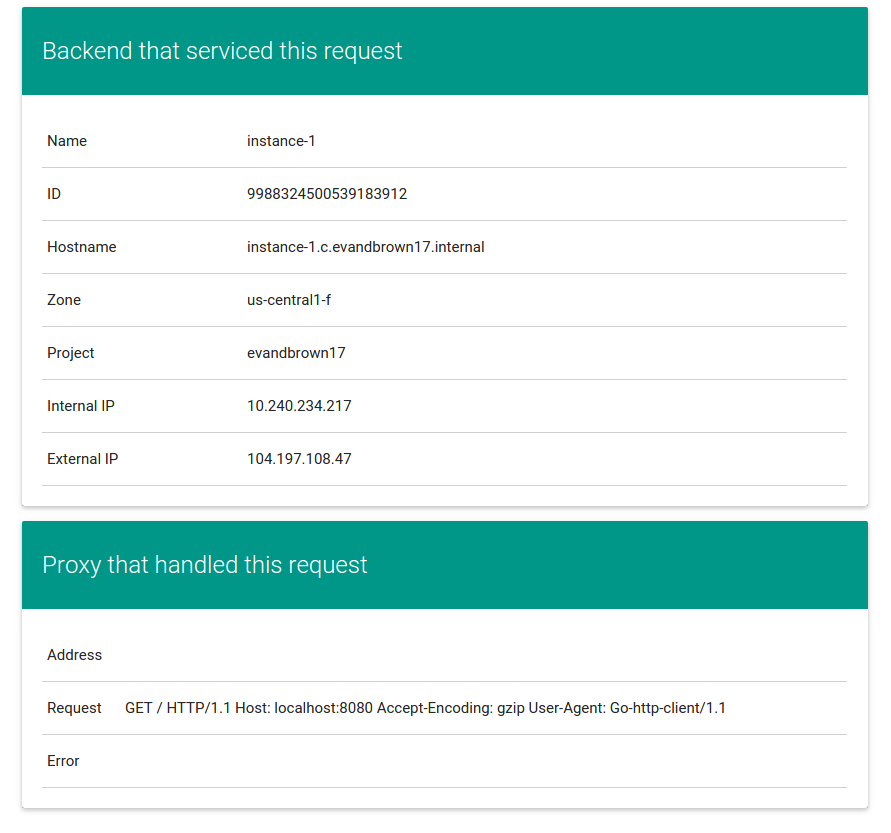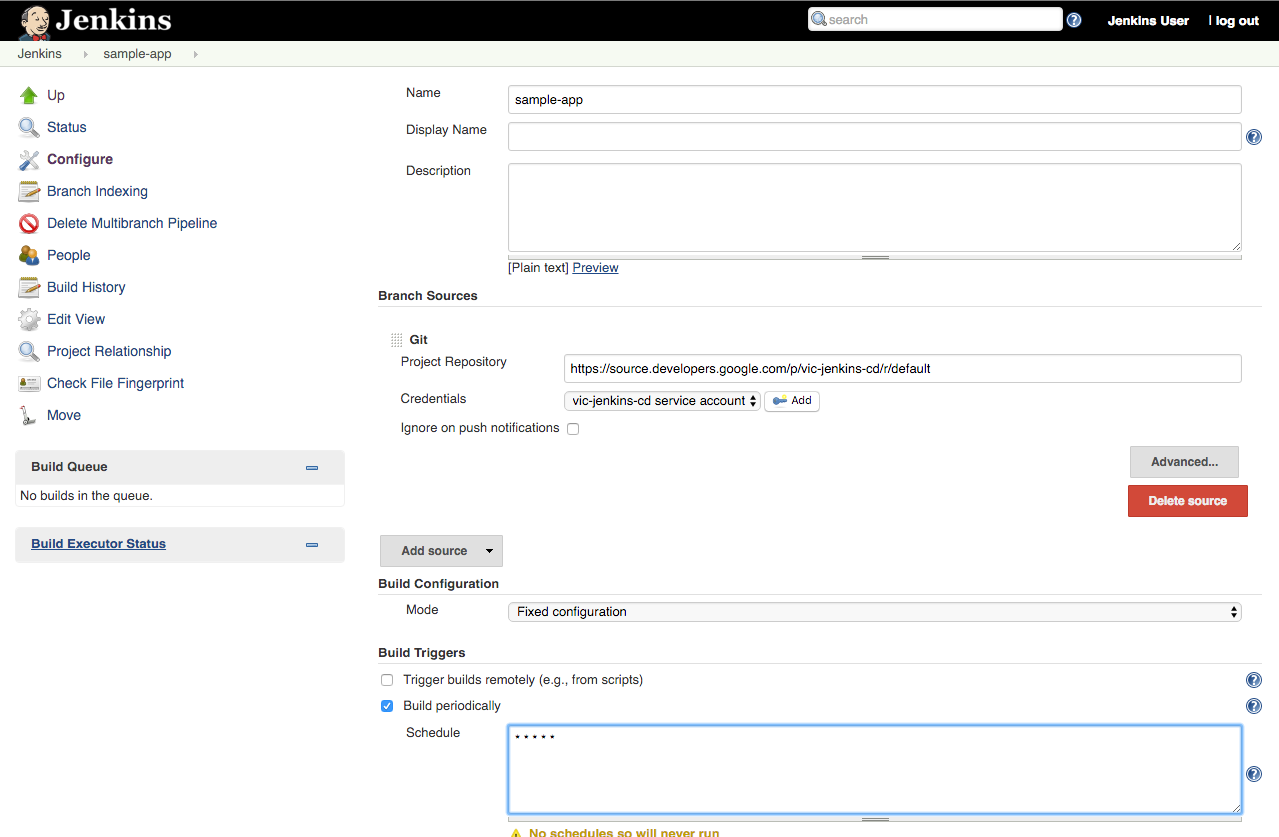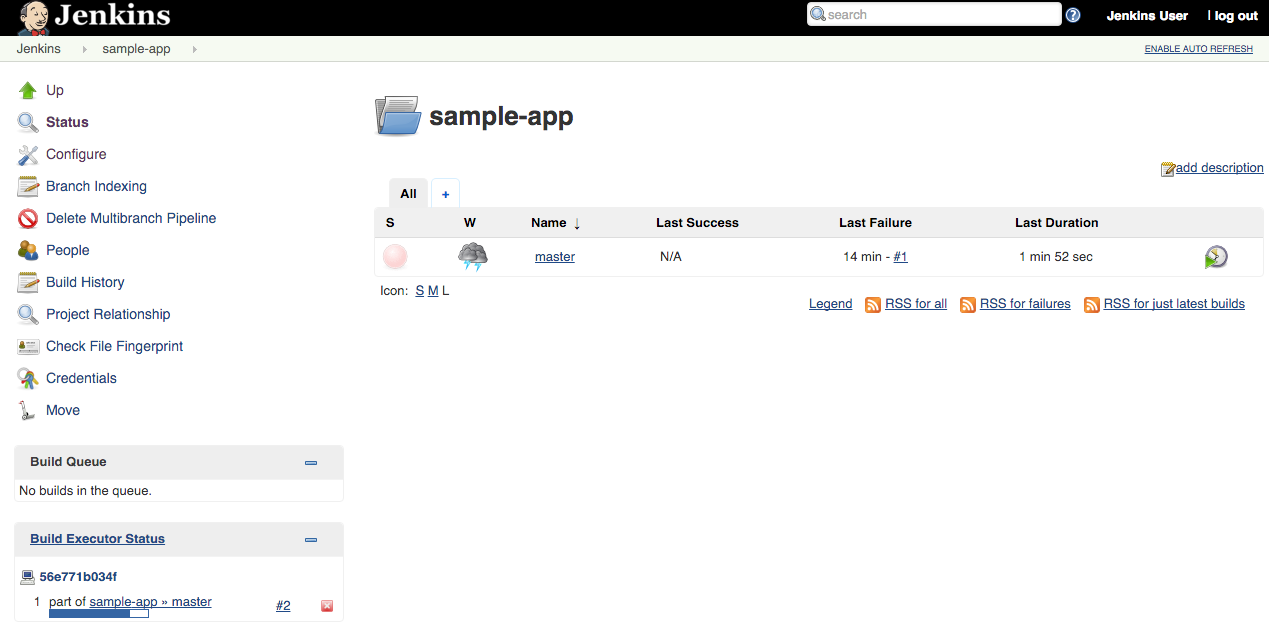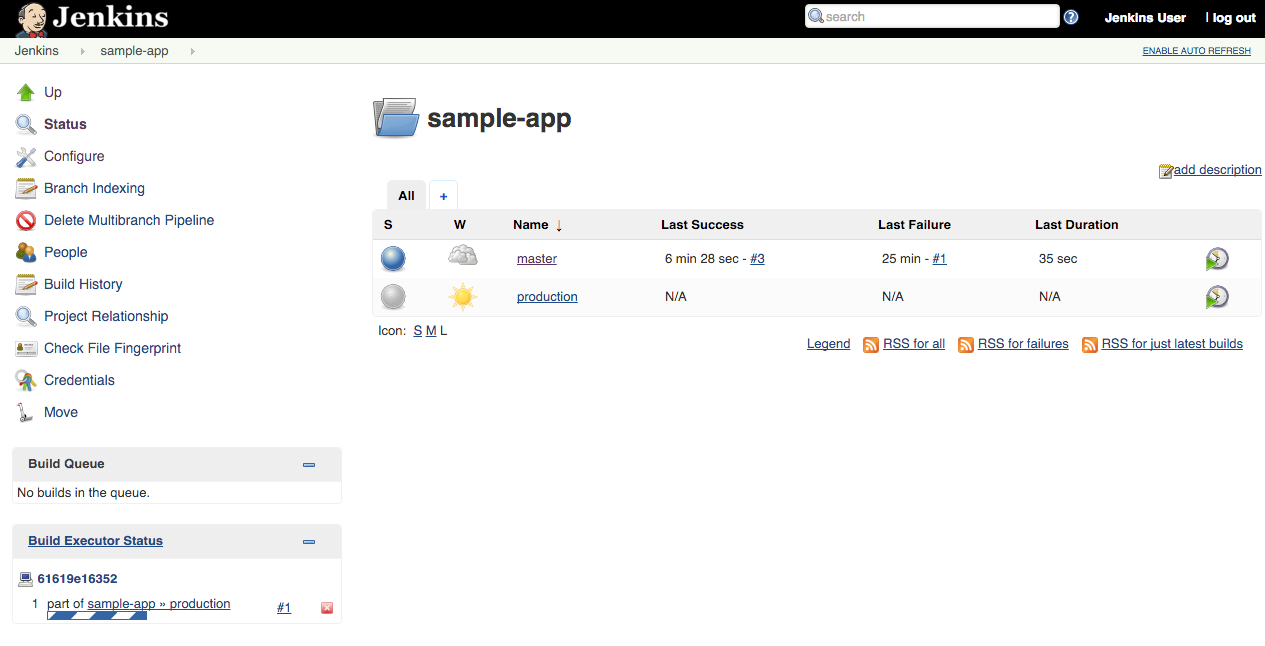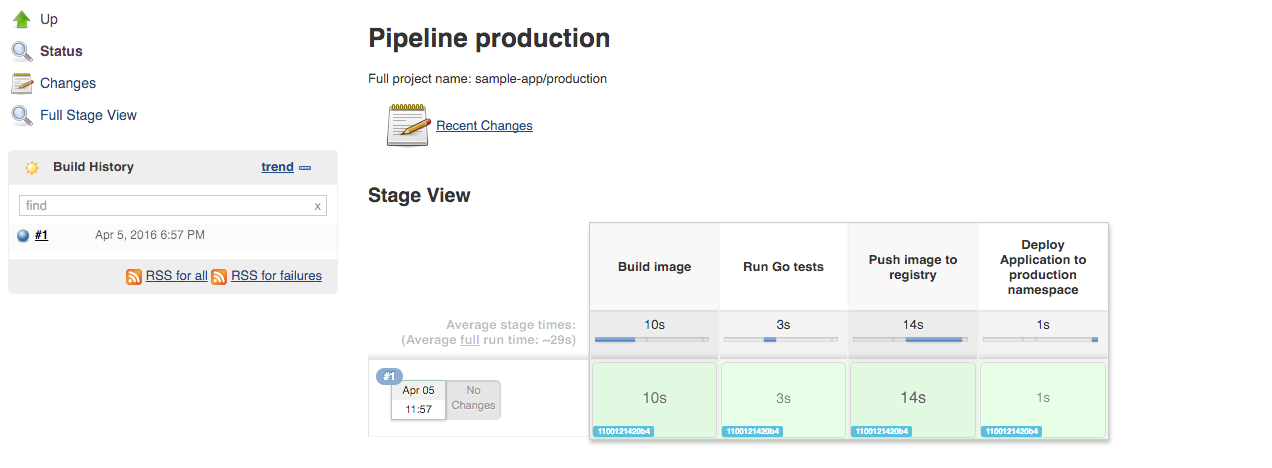This guide will take you through the steps necessary to continuously deliver your software to end users by leveraging Google Container Engine and Jenkins to orchestrate the software delivery pipeline. If you are not familiar with basic Kubernetes concepts, have a look at Kubernetes 101.
In order to accomplish this goal you will use the following Jenkins plugins:
- Jenkins Kubernetes Plugin - start Jenkins build executor containers in the Kubernetes cluster when builds are requested, terminate those containers when builds complete, freeing resources up for the rest of the cluster
- Jenkins Pipelines - define our build pipeline declaratively and keep it checked into source code management alongside our application code
In order to deploy the application with Kubernetes you will use the following resources:
- Deployments - replicates our application across our kubernetes nodes and allows us to do a controlled rolling update of our software across the fleet of application instances
- Services - load balancing and service discovery for our internal services
- Ingress - external load balancing and SSL termination for our external service
- Secrets - secure storage of non public configuration information, SSL certs specifically in our case
- A Google Cloud Platform Account
- Enable the Google Compute Engine and Google Container Engine APIs
In this section you will start your Google Cloud Shell and clone the lab code repository to it.
-
Create a new Google Cloud Platform project: https://console.developers.google.com/project
-
Click the Google Cloud Shell icon in the top-right and wait for your shell to open:
- When the shell is open, set your default compute zone:
$ gcloud config set compute/zone us-east1-d- Clone the lab repository in your cloud shell, then
cdinto that dir:
$ git clone https://github.com/GoogleCloudPlatform/continuous-deployment-on-kubernetes.git
Cloning into 'continuous-deployment-on-kubernetes'...
...
$ cd continuous-deployment-on-kubernetesYou'll use Google Container Engine to create and manage your Kubernetes cluster. Provision the cluster with gcloud:
$ gcloud container clusters create jenkins-cd \
--num-nodes 3 \
--scopes "https://www.googleapis.com/auth/projecthosting,storage-rw"Once that operation completes download the credentials for your cluster using the gcloud CLI:
$ gcloud container clusters get-credentials jenkins-cd
Fetching cluster endpoint and auth data.
kubeconfig entry generated for jenkins-cd.Confirm that the cluster is running and kubectl is working by listing pods:
$ kubectl get podsYou should see an empty response.
Create the jenkins namespace:
$ kubectl create ns jenkinsIn order to pre-populate Jenkins with the necessary plugins and configuration for the rest of the tutorial, you will create a volume from an existing tarball of that data.
gcloud compute images create jenkins-home-image --source-uri https://storage.googleapis.com/solutions-public-assets/jenkins-cd/jenkins-home.tar.gz
gcloud compute disks create jenkins-home --image jenkins-home-imageHere you'll create a Deployment running a Jenkins container with a persistent disk attached containing the Jenkins home directory.
First, set the password for the default Jenkins user. Edit the password in jenkins/k8s/options with the password of your choice by replacing CHANGE_ME. To Generate a random password and replace it in the file, you can run:
$ PASSWORD=`openssl rand -base64 15`; echo "Your password is $PASSWORD"; sed -i.bak s#CHANGE_ME#$PASSWORD# jenkins/k8s/options
Your password is 2UyiEo2ezG/CKnUcgPxtNow create the secret using kubectl:
$ kubectl create secret generic jenkins --from-file=jenkins/k8s/options --namespace=jenkins
secret "jenkins" createdAdditionally you will have a service that will route requests to the controller.
Note: All of the files that define the Kubernetes resources you will be creating for Jenkins are in the
jenkins/k8sfolder. You are encouraged to take a look at them before running the create commands.
The Jenkins Deployment is defined in kubernetes/jenkins.yaml. Create the Deployment and confirm the pod was scheduled:
$ kubectl apply -f jenkins/k8s/
deployment "jenkins" created
service "jenkins-ui" created
service "jenkins-discovery" createdThe Jenkins UI service was implemented with a NodePort. We will need to get the port that was exposed in order to allow the Ingress HTTP load balancer to reach the UI:
$ kubectl describe svc --namespace jenkins jenkins-ui
Name: jenkins-ui
Namespace: jenkins
Labels: <none>
Selector: app=master
Type: NodePort
IP: 10.123.123.123
Port: ui 8080/TCP
NodePort: ui 30573/TCP <----- THIS IS THE PORT NUMBER OPENED UP ON EACH CLUSTER NODE
Endpoints: <none>
Session Affinity: None
No events.Next we will open up the firewall to allow access to those ports:
$ export NODE_PORT=$(kubectl get --namespace=jenkins -o jsonpath="{.spec.ports[0].nodePort}" services jenkins-ui)
$ gcloud compute firewall-rules create allow-130-211-0-0-22-$NODE_PORT --source-ranges 130.211.0.0/22 --allow tcp:$NODE_PORT
Created [https://www.googleapis.com/compute/v1/projects/vic-goog/global/firewalls/allow-130-211-0-0-22].
NAME NETWORK SRC_RANGES RULES SRC_TAGS TARGET_TAGS
allow-130-211-0-0-22 default 130.211.0.0/22 tcp:30573 gke-jenkins-cd-e5d0264b-nodeCheck that your master pod is in the running state
$ kubectl get pods --namespace jenkins
NAME READY STATUS RESTARTS AGE
jenkins-master-to8xg 1/1 Running 0 30sNow, check that the Jenkins Service was created properly:
$ kubectl get svc --namespace jenkins
NAME CLUSTER-IP EXTERNAL-IP PORT(S) AGE
jenkins-discovery 10.79.254.142 <none> 50000/TCP 10m
jenkins-ui 10.79.242.143 nodes 8080/TCP 10mWe are using the Kubernetes Plugin so that our builder nodes will be automatically launched as necessary when the Jenkins master requests them. Upon completion of their work they will automatically be turned down and their resources added back to the clusters resource pool.
Notice that this service exposes ports 8080 and 50000 for any pods that match the selector. This will expose the Jenkins web UI and builder/agent registration ports within the Kubernetes cluster.
Additionally the jenkins-ui services is exposed using a NodePort so that our HTTP loadbalancer can reach it.
Kubernetes makes it simple to deploy an Ingress resource to act as a public load balancer and SSL terminator.
The Ingress resource is defined in jenkins/k8s/lb/ingress.yaml. We used the Kubernetes secrets API to add our certs securely to our cluster and ready for the Ingress to use.
In order to create your own certs run:
$ openssl req -x509 -nodes -days 365 -newkey rsa:2048 -keyout /tmp/tls.key -out /tmp/tls.crt -subj "/CN=jenkins/O=jenkins"Now you can upload them to Kubernetes as secrets:
$ kubectl create secret generic tls --from-file=/tmp/tls.crt --from-file=/tmp/tls.key --namespace jenkinsNow that the secrets have been uploaded, create the ingress load balancer. Note that the secrets must be created before the ingress, otherwise the HTTPs endpoint will not be created.
$ kubectl apply -f jenkins/k8s/lbNow find the load balancer IP address of your Ingress service (in the Address field). This field may take a few minutes to appear as the load balancer is being provisioned:
$ kubectl get ingress --namespace jenkins
NAME RULE BACKEND ADDRESS AGE
jenkins - master:8080 130.X.X.X 4mThe loadbalancer will begin health checks against your Jenkins instance. Once the checks go to healthy you will be able to access your Jenkins instance:
$ kubectl describe ingress jenkins --namespace jenkins
Name: jenkins
Namespace: jenkins
Address: 130.211.14.253
Default backend: jenkins-ui:8080 (10.76.2.3:8080)
TLS:
tls terminates
Rules:
Host Path Backends
---- ---- --------
Annotations:
https-forwarding-rule: k8s-fws-jenkins-jenkins
https-target-proxy: k8s-tps-jenkins-jenkins
static-ip: k8s-fw-jenkins-jenkins
target-proxy: k8s-tp-jenkins-jenkins
url-map: k8s-um-jenkins-jenkins
backends: {"k8s-be-32371":"HEALTHY"} <---- LOOK FOR THIS TO BE HEALTHY
forwarding-rule: k8s-fw-jenkins-jenkins
Events:
FirstSeen LastSeen Count From SubobjectPath Type Reason Message
--------- -------- ----- ---- ------------- -------- ------ -------
2m 2m 1 {loadbalancer-controller } Normal ADD jenkins/jenkins
1m 1m 1 {loadbalancer-controller } Normal CREATE ip: 130.123.123.123 <--- This is the load balancer's IPOpen the load balancer's IP address in your web browser, click "Log in" in the top right and sign in with the default Jenkins username jenkins and the password you configured when deploying Jenkins. You can find the password in the jenkins/k8s/options file.
Note: To further secure your instance follow the steps found here.
You've got a Kubernetes cluster managed by Google Container Engine. You've deployed:
- a Jenkins Deployment
- a (non-public) service that exposes Jenkins to its slave containers
- an Ingress resource that routes to the Jenkins service
You have the tools to build a continuous deployment pipeline. Now you need a sample app to deploy continuously.
You'll use a very simple sample application - gceme - as the basis for your CD pipeline. gceme is written in Go and is located in the sample-app directory in this repo. When you run the gceme binary on a GCE instance, it displays the instance's metadata in a pretty card:
The binary supports two modes of operation, designed to mimic a microservice. In backend mode, gceme will listen on a port (8080 by default) and return GCE instance metadata as JSON, with content-type=application/json. In frontend mode, gceme will query a backend gceme service and render that JSON in the UI you saw above. It looks roughly like this:
----------- ------------ ~~~~~~~~~~~~ -----------
| | | | | | | |
| user | ---> | gceme | ---> | lb/proxy | -----> | gceme |
|(browser)| |(frontend)| |(optional)| | |(backend)|
| | | | | | | | |
----------- ------------ ~~~~~~~~~~~~ | -----------
| -----------
| | |
|--> | gceme |
|(backend)|
| |
-----------
Both the frontend and backend modes of the application support two additional URLs:
/versionprints the version of the binary (declared as a const inmain.go)/healthzreports the health of the application. In frontend mode, health will be OK if the backend is reachable.
In this section you will deploy the gceme frontend and backend to Kubernetes using Kubernetes manifest files (included in this repo) that describe the environment that the gceme binary/Docker image will be deployed to. They use a default gceme Docker image that you will be updating with your own in a later section.
You'll have two primary environments - staging and production - and use Kubernetes namespaces to isolate them.
Note: The manifest files for this section of the tutorial are in
sample-app/k8s. You are encouraged to open and read each one before creating it per the instructions.
- First change directories to the sample-app:
$ cd sample-app- Create the namespace for production:
$ kubectl create ns production-
Create the staging and production Deployments and Services:
$ kubectl --namespace=production apply -f k8s/production $ kubectl --namespace=production apply -f k8s/staging $ kubectl --namespace=production apply -f k8s/services
-
Scale the production service:
$ kubectl --namespace=production scale deployment gceme-frontend-production --replicas=4
-
Retrieve the External IP for the production services: This field may take a few minutes to appear as the load balancer is being provisioned:
$ kubectl --namespace=production get service gceme-frontend
NAME CLUSTER-IP EXTERNAL-IP PORT(S) AGE
gceme-frontend 10.79.241.131 104.196.110.46 80/TCP 5h- Store frontend service load balancer IP in the environment variable:
$ export FRONTEND_SERVICE_IP=$(kubectl get -o jsonpath="{.status.loadBalancer.ingress[0].ip}" --namespace=production services gceme-frontend)-
Confirm that both services are working by opening the frontend external IP in your browser
-
Open a terminal and poll the production endpoint's
/versionURL so you can easily observe rolling updates in the next section:$ while true; do curl http://$FRONTEND_SERVICE_IP/version; sleep 1; done
Here you'll create your own copy of the gceme sample app in Cloud Source Repository.
- Change directories to
sample-appof the repo you cloned previously, then initialize the git repository.
Be sure to replace REPLACE_WITH_YOUR_PROJECT_ID with the name of your Google Cloud Platform project
```shell
$ cd sample-app
$ git init
$ git config credential.helper gcloud.sh
$ git remote add origin https://source.developers.google.com/p/REPLACE_WITH_YOUR_PROJECT_ID/r/default
```
-
Ensure git is able to identify you:
$ git config --global user.email "YOUR-EMAIL-ADDRESS" $ git config --global user.name "YOUR-NAME"
-
Add, commit, and push all the files:
$ git add . $ git commit -m "Initial commit" $ git push origin master
You'll now use Jenkins to define and run a pipeline that will test, build, and deploy your copy of gceme to your Kubernetes cluster. You'll approach this in phases. Let's get started with the first.
First we will need to configure our GCP credentials in order for Jenkins to be able to access our code repository
- In the Jenkins UI, Click “Credentials” on the left
- Click “Global Credentials”
- Click “Add Credentials” on the left
- From the “Kind” dropdown, select “Google Service Account from metadata”
- Click “OK”
You should now see 2 Global Credentials. Make a note of the name of second credentials as you will reference this in Phase 2:
This lab uses Jenkins Pipeline to define builds as groovy scripts.
Navigate to your Jenkins UI and follow these steps to configure a Pipeline job (hot tip: you can find the IP address of your Jenkins install with kubectl get ingress --namespace jenkins):
-
Click the “Jenkins” link in the top left of the interface
-
Click the New Item link in the left nav
-
Name the project sample-app, choose the Multibranch Pipeline option, then click
OK -
Click
Add Sourceand choosegit -
Paste the HTTPS clone URL of your
sample-apprepo on Cloud Source Repositories into the Project Repository field. It will look like: https://source.developers.google.com/p/REPLACE_WITH_YOUR_PROJECT_ID/r/default -
From the Credentials dropdown select the name of new created credentials from the Phase 1.
-
Under "Build Triggers", check "Build Periodically" and enter "* * * * *" in to the "Schedule" field, this will ensure that Jenkins will check our repository for changes every minute.
-
Click
Save, leaving all other options with their defaults
A job entitled "Branch indexing" was kicked off to see identify the branches in your repository. If you refresh Jenkins you should see the master branch now has a job created for it.
The first run of the job will fail until the project name is set properly in the next step.
Create a branch for the staging environment called staging
$ git checkout -b stagingThe Jenkinsfile is written using the Jenkins Workflow DSL (Groovy-based). It allows an entire build pipeline to be expressed in a single script that lives along side supports your source code and powerful features like parallelization, stages, and user input.
Modify your Jenkinsfile script so it contains the correct project name on line 2.
Be sure to replace REPLACE_WITH_YOUR_PROJECT_ID on line 2 with your project name:
Don't commit the new Jenkinsfile just yet. You'll make one more change in the next section, then commit and push them together.
Phase 4: Deploy a canary release to staging
Now that your pipeline is working, it's time to make a change to the gceme app and let your pipeline test, package, and deploy it.
The staging environment is rolled out as a percentage of the pods behind the production load balancer.
In this case we have 1 out of 5 of our frontends running the staging code and the other 4 running the production code. This allows you to ensure that the staging code is not negatively affecting users before rolling out to your full fleet.
You can use the labels env: production and env: staging in Google Cloud Monitoring in order to monitor the performance of each version individually.
- In the
sample-apprepository on your workstation openhtml.goand replace the wordbluewithorange(there should be exactly two occurrences):
//snip
<div class="card orange">
<div class="card-content white-text">
<div class="card-title">Backend that serviced this request</div>
//snip-
In the same repository, open
main.goand change the version number from1.0.0to2.0.0://snip const version string = "2.0.0" //snip
-
git add Jenkinsfile html.go main.go, thengit commit -m "Version 2", and finallygit push origin stagingyour change. -
When your change has been pushed to the Git repository, navigate to Jenkins. Your build should start shortly.
- Once the build is running, click the down arrow next to the build in the left column and choose Console Output:
-
Track the output for a few minutes and watch for the
kubectl --namespace=production apply...to begin. When it starts, open the terminal that's polling staging's/versionURL and observe it start to change in some of the requests. You have now rolled out that change to a subset of users. -
Once the change is deployed to staging, you can continue to roll it out to the rest of your users by creating a branch called
productionand pushing it to the Git server:$ git checkout master $ git merge staging $ git push origin master
-
In a minute or so you should see that the master job in the sample-app folder has been kicked off:
-
Clicking on the
masterlink will show you the stages of your pipeline as well as pass/fail and timing characteristics. -
Poll the production url in order to verify that the new version (2.0.0) has been rolled out and is serving all requests:
$ while true; do curl http://$FRONTEND_SERVICE_IP/version; sleep 1; done
-
Look at the
Jenkinsfilein the project to see how the workflow is written.
Often times changes will not be so trivial that they can be pushed directly to the staging environment. In order to create a development environment from a long lived feature branch
all you need to do is push it up to the Git server and let Jenkins deploy your environment. In this case you will not use a loadbalancer so you'll have to access your application using kubectl proxy,
which authenticates itself with the Kuberentes API and proxies requests from your local machine to the service in the cluster without exposing your service to the internet.
- Create another branch and push it up to the Git server
$ git checkout -b new-feature $ git push origin new-feature
You should see that a new job has been created and your environment is being created. At the bottom of the console output of the job you will see instructions for accessing your environment. Namely:
-
Start the proxy
$ kubectl proxy
-
Access your application via localhost:
$ curl http://localhost:8001/api/v1/proxy/namespaces/new-feature/services/gceme-frontend:80/
-
You can now push code to this branch in order to update your development environment. Once you are done, merge your branch back into master to deploy that code to the staging environment:
$ git checkout master $ git merge new-feature $ git push master
-
When you are confident that your code won't wreak havoc in production merge from the
masterbranch to theproductionbranch. Your code will be automatically rolled out in the production environment:
$ git checkout production
$ git merge master
$ git push production- When you are done with your development branch, delete it from the server and delete the environment in Kubernetes:
$ git push origin :new-feature
$ kubectl delete ns new-featureMake a breaking change to the gceme source, push it, and deploy it through the pipeline to production. Then pretend latency spiked after the deployment and you want to roll back. Do it! Faster!
Things to consider:
- What is the Docker image you want to deploy for roll back?
- How can you interact directly with the Kubernetes to trigger the deployment?
- Is SRE really what you want to do with your life?
Clean up is really easy, but also super important: if you don't follow these instructions, you will continue to be billed for the Google Container Engine cluster you created.
To clean up, navigate to the Google Developers Console Project List, choose the project you created for this lab, and delete it. That's it.



